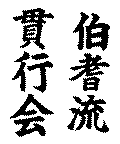
Hōki-ryū iaidō
at Yobushin Dojo, Indiana
 |
Hōki-ryū iaidōat Yobushin Dojo, Indiana |
FAQWhat is Hōki-ryū? What is Iaidō?Founded around 1596 by Katayama Hisayasu, Hōki-ryū is a classical tradition of iaidō (ee-EYE-doe), which is a form of Japanese swordsmanship that specializes in the art of drawing the sword to respond to an attack. The word iaidō may be glossed as the "way (dō) of meeting (ai) whatever situation one is in (i)," and as a martial metaphor, iai refers to the act of sword drawing. Indeed, only by inhabiting the moment with the fullness of mind and spirit can one be prepared for any eventuality, wherever one is (tsune ni ite, kyū ni awasu), even with the disadvantage of a sheathed sword. Properly pursued, iaidō is a path of combative, physical, and mental development, teaching the practitioner to move with grace and balance, and to focus on the here-and-now.
Hōki-ryū has a curriculum of fifteen solo kata (prearranged practice patterns) that teaches fighting from the scabbard in a number of combative scenarios (e.g., suddenly being attacked by someone from behind). The practice of these kata is characterized by the presence of mind and the exactitude of technique. The student should approach each repetition as the one chance in a lifetime (ichi go, ichi e) to do the kata, giving it their all. Though an iai training session may strike the casual observer as “Zen-like” or tranquil, upon closer examination he or she will discern the intense concentration and the martial intent beneath the surface. Only with the proper mental disposition can the students drill kata and cultivate the synergy of spirit, sword, and body (ki-ken-tai itchi).
Practicing iaidō requires either an unsharpened sword made from an aluminum alloy (iaitō) or, at the advanced level, a live blade forged in the traditional Japanese fashion (shinken). The uniform derives from traditional samurai clothing, consisting of iaigi (jacket), hakama (wide pleated trousers), and iai obi (a wide belt). Unlike kendo, iaidō uses no protective coverings. The overall appearance generally conveys austerity and dignity. For more information, read on, but also read the history page, as well as Diane Skoss’ article "Koryū Primer," which explains what a koryū (classical tradition) is. What Makes Hōki-ryū Unique?Born of a particular culture and time, Hōki-ryū does not merely teach how to draw the sword, but it also offers a look into the past. Its four-hundred year history makes up a part of what it is. As a classcal art, Hōki-ryū offers a path for self-cultivation, yet discloses its meaning only to those who commit to training their spirit and body in the long term. The students must overcome the challenges that arise in the pursuit of this discipline, perfecting the techniques and forging their spirit (seishin tanren). Such issues cannot be adequately addressed here, so instead we offer a few brief observations about Hōki-ryū’s practice below.
Other than the general points above, Hōki-ryū is also distinguished by a number of specific technical features:
Is Hōki-ryū Iaidō or Iaijutsu?Nakayama Hakudo (1873-1958), the revitalizer of Shinden-ryū, coined the term iaidō to distinguish his modern form of iai from classical iaijustu (“the art of iai”). Hōki-ryū, however, does not observe this distinction, and uses these two words rather arbitrarily. Certain lines of Hōki-ryū refer to their practice as iaidō, while others employ the term iaijutsu, though we all practice effectively the same material. For Hōki-ryū, the choice of the term does not mean that we align ourselves with the modern rather than the classical (or vice versa), or that we are a "spiritually"-oriented -dō art rather than a "combatively"-oriented -jutsu art (or vice versa). Our school calls our practice iaidō, but we are also koryū. For a more thorough explanation, see Rennis Buchner's "The More Things Change, the More Things Stay the Same." (digital archive from 2016) How Can I Join Your School?Typically, a prospective student should make an appointment to observe a class. Afterwards he or she will discuss the possibility of joining the school with the instructor. Our classes are small, and the instructor invests a substantial amount of time and energy on each individual student, necessitating a screening process to discern the prospective's suitability and interest. Upon admission, the student should consult with the instructor before investing in training equipment.
[ Home | FAQ | History | Curriculum | Instructors | Links ] |
||||||||||||||